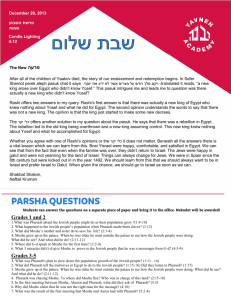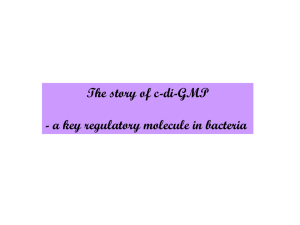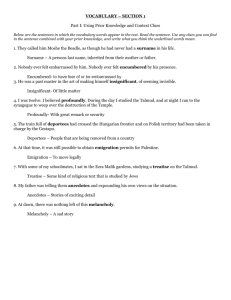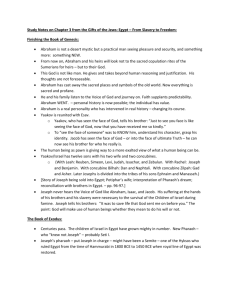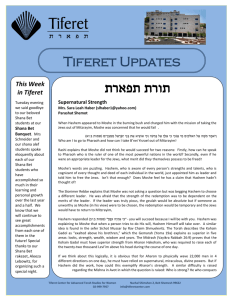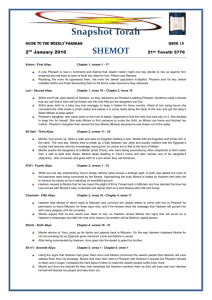Chumash
advertisement
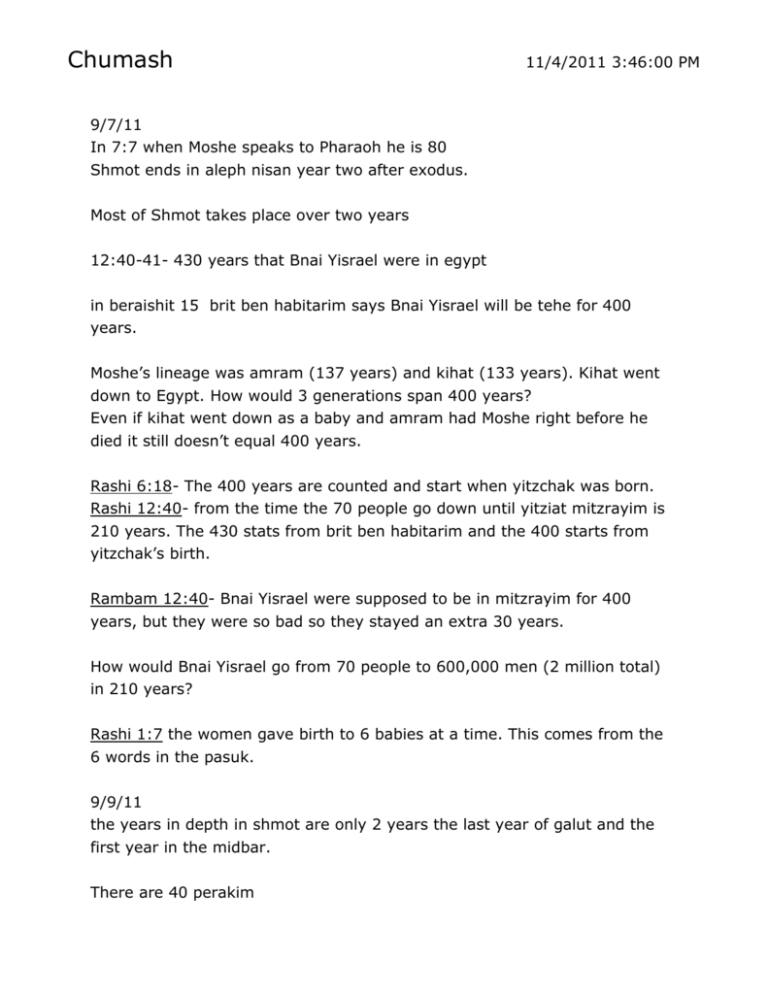
Chumash 11/4/2011 3:46:00 PM 9/7/11 In 7:7 when Moshe speaks to Pharaoh he is 80 Shmot ends in aleph nisan year two after exodus. Most of Shmot takes place over two years 12:40-41- 430 years that Bnai Yisrael were in egypt in beraishit 15 brit ben habitarim says Bnai Yisrael will be tehe for 400 years. Moshe’s lineage was amram (137 years) and kihat (133 years). Kihat went down to Egypt. How would 3 generations span 400 years? Even if kihat went down as a baby and amram had Moshe right before he died it still doesn’t equal 400 years. Rashi 6:18- The 400 years are counted and start when yitzchak was born. Rashi 12:40- from the time the 70 people go down until yitziat mitzrayim is 210 years. The 430 stats from brit ben habitarim and the 400 starts from yitzchak’s birth. Rambam 12:40- Bnai Yisrael were supposed to be in mitzrayim for 400 years, but they were so bad so they stayed an extra 30 years. How would Bnai Yisrael go from 70 people to 600,000 men (2 million total) in 210 years? Rashi 1:7 the women gave birth to 6 babies at a time. This comes from the 6 words in the pasuk. 9/9/11 the years in depth in shmot are only 2 years the last year of galut and the first year in the midbar. There are 40 perakim Perek 20 is aseret hadibrot The sefer took place in 3 locations. Mitzrayim, biderech, and har sinai. Umberto Cassuto- splits the book up into 3 differentsly and says the first is “seavub vitiziat mitzrayim” the second is “torah vihamitzvah” and the third is “mishkan” Moshe’s words to pharaoh “shilach at ami viavdeni” 20:23 this statement is split up into two like the sefer. shilach at ami shmot to bishalach viavdeni yitro to pekudei ramban comments on what the theme of the sefer is about and he has a hakdama before each sefer. 9/12/11 Rambam Sect I: overview of beraishit (ends with hahem) Sect II: recap of shviim nefesh Sect III- theme of shmot I Ramabm refers to beriashit as yitzirah, its nickname, because the book is about the creation of the world and the creation of Bnai Yisrael. The avot created a world for their children- maaseh avot siman libanim. (like avraham going down to mitzrayim was bad). II Why does shmot begin with shviim nefesh? The theme of shmot is galut ogiulah so we have to begin with the beginning of galut which is the shviim nefesh. That’s why the names are repeated from before. III What is the geulah? The sefer doesn’t end with complete geulah (Bnai Yisrael don’t enter Israel). It should end with bishalach (yiztait mitzrayim). It ends with the mishkan so then we must ask why the mishkan is linked to geulah? Geulah isn’t fulfilled until Bnai Yisrael aren’t at their spiritual high. When Bnai Yisrael have har sinai and Hashem’s shechinah is in the mishkan, we have been redeemed and return to the level of our avot. Only then are we considered redeemed. Gemara pisachim- rav says to begin with the bad and end with good. What is the bad? Rav says it is that terach and nachor were oved avoda zarah. Shmuel says we should start with avadim hayinu. Rav solovetchik9/13/11 Perek Aleph 1-7 shviim nefesh why would it repeat the story of the 70 nefesh if we already know their names? Similarities All of yaakov’s 12 sons mentioned Dina not mentioned Yoseph dies Both have same total as 70 Same phrase “eleh shmot Bnai Yisrael habaim mitzraymah” Differences Shmot just had the name of yaakov’s 12 sons while beraishit lists everyone. There is more biographical information in shmot Different order of Bnai yaakov. In beraishit it is leah, zilpah, rachel, bilha. In shmot it is leah, rachel, bilhah, zilpah. Shmot says that Bnai Yisrael reproduced a lot and beraishit doesn’t Berasihit does mention this but it doesn’t talk about rapid reproduction In shmot it talks about filling the entire land and has 6 words to describe it Shmot mentions that the entire generation died. Shmot is different because it explains why pharaoh look at Bnai Yisrael as strong. Beraishit focuses on individuals and maintains the family unit (that is why the rder of mothers appears that way). Shmot is about the development of the am. The mother’s order is based on hierarchy kind of like a nation would have. Bnai Yisrael is used twice from 1-7. The first time is about yaakov’s children, but the second refers to the nation as the torah will continue to do. Egyptians themselves were angry at the Jews because they were rich and living well and they convicned pharoah to be angry at them. Pharaoh is the first person to refer to bani Yisrael as an am. 9/14/11 Beraishit Genesis Sefer hayiztirah/yashar Shmot Exodus Sefer hageulah Vayikra Leviticus Torat kohanim Bamidbar Numbers Sefer hapikudim Divarim Deuteronomy Mishna torah the bihag changes the name of shmo to sefer hasheni. The nitzi says that the bihag based his names off of the Gemara but he asks why he would keep the nicknames for some , but number shmot, it should be consistent. The nitzi answers that shmot is the completion of the creation. Beriashit is more about a limited amount of people when it says l”lizarecha eiten et haaretz hazot” which is about certain kids and one place However the first plan was piru orivu umelu et haaretz which was for all children and everyone. Why would am Yisrael be a creation? Where else is there a link between shmot and beraishit? Shviim nefesh Vi’eleh shmot o With the vv it shows that there is a sequel Brit bein habitarim o It is fulfilled in shmot Bnai Yisrael fulfill the bracha of piru virivu vitimaleh The mabul was like a re-creation It is redoing beriashit People don’t like mondayd and Hashem doesn’t say that iti is ki tov but that is because many say it wasn’t finished. It may each us that we shouldn’t be upset at the beginning when we don’t yet know the end. When the end comes all will be good. 9/16/11 get notes from beginning we are conserving this pharoah so there is only one really bad pharoah and not more. 1:8- vayikam melach chadash asher lo yadah et yoseph- this seems to make more sense with melech chadash mamash. Rashi mallika- chadash mamash shenitchadshu gizeirotav acts as if he doesn’t remember yoseph yada is known personally onkelos- acts contrary to what yoseph did nachum sarna says it is vayakam melech chadash means a new dynasty not a new king. If it was anew king it should say vayimloch. Josephus- lived in 1st century CE, not necessarily accurate, but we do get a lot of information from him. he defends the cannon of the bible. Hyksos ruled in lower egypt. They were called foreign rulers and the egptians were angry. One of the pharaohs defeated the hyksos. Josephus says that our forefathers were the hyksos There is only evidence of settlement in Israel in the 13th century no the 16th century when the hyksos left egypt Exodus probably happened around the 13th century with Seti I and ramses II (pitom and ramses). 9/19/11 Josephus said exodus happened in 16th century and when they were kicked out yitziat mitzrayim happened. There is no evidence of people conquering Israel in the 16th century. The hyksos makes sense for yoseph going down during their time because it would be weird for the egyptians to allow a foreign ruler to rule. It explaisn how he can marry an “egyptian” women dn why pharoah was so paranoid about the Jews taking over. 1:9-10 Rav viatzum mimenu- they are larger and stronger than us (how can this be true that the Jews were more than the egyptains) rav hirsch- minenu probably means ”for us”. so it means that the Jews are too many for the egyptians to deal with. “ki tikreunu milchama”- there will be a war “nosaf…soneinu” join the enemies “alah min haaretz” isn’t that good that their enemies will leave the land. Get notes from end Beg Gidolah Aval bishlama achrei otam vihaeinyan nikmah txifno vinireh hachamas vizeh bamirmah 9/20/11 Ramban (havah nichachma)- (it was not as bad in the beginning and then it got worse later. It was a slow progression). Why does pharaoh not openly kill Bnai Yisrael? We cannot kill the people who the previous king invited and allowed them to settle in the land. The people would not accept killing them Bnai Yisrael would fight back if we came out against them strongly. Ramban translates “havah nichachma” as let us do it in a sly way where they wouldn’t think that they are being persecuted. Tax (1:11-14) o Slavery is the tax like shlomo did o The Jews wouldn’t feel hated when this was done because many foreign countries do this o This is an indirect solution to the problem Midwives kill the babies (1:15-21) o This was completely secretive o The mothers wouldn’t even know that the babies are dead because the midwives will say that the baby was a stillborn. o This is a direct solution to the problem 9/21/11 Throw the boys in the Nile o Pharaoh doesn’t tell his executioners to kill the boys. He tells the nation that if they find a Jewish boy they will throw him in. There would be no evidence against pharaoh because the Egyptians are doing it, he isn’t doing it directly. o This is a direct solution to the problem At the beginning ramban says the people would not accept killing the Jews. However, at the end they did because he did a slow progression. What motivates pharaoh to keep his plant going? (it seemed like he may not have wanted to kill everyone at the beginning, but at the end he did). At every stage it talks about Bnai Yisrael multiplying more and more. There is no pasuk that says that Bnai Yisrael are multiplying after throwing the babies in the well. But in perek bet it says that Moshe was saved which shows that it was still going on. Rashi 12- it’s like the pshat. Pharaoh’s original fear is “pen yirbeh” lest they multiply. This pasuk says “kein yirbeh” they did multiply. The first thing that Bnai Yisrael did in the labor tax was building royal cities. The sarei misim lead this (the right hand men of pharaoh).But it fails because Bnai Yisrael multiply. Then it becomes avoda kasheh. Also the egyptians themselves are in charge and not just the sarei misim. Now they are doing mindless and endless work. Rabbi samet- it was not one step. The step of slavery was split into two. Both plans undergo a shiftwhen pharaoh is originally subtle but then he becomes less subtle. Compare hitler to pharoah or who is worse Was it rational or not? Etc 1-9 mohes birth and nile travels 10 gmoshe gorws up 11-12 kills egyptisn 13-15 stops Jew Moshe runs 16-22 Moshe in midyan 23-15 new king harsher 9/23/11 get notes 9/27/11 odes miyaldot ivriot mean that they were for the Jews or were they Jewish? As the nation grows they lose their names. There are 12 chidlren at the beginning Sforno- yitzritzu was in beraishit talking about the bugs. He says it means that they were bad like ants and not just reproducing like them. The perek is about Moshe. There is a shift between the nation in perek aleph and Moshe in perek bet. The stage so of phaorah’s persecution robs the Jews more of their identity. Sarna- shifra and puah have names which shows that they are on a high level. The torah is on biblical levels. If this is an intimate story about a family but why is the only name in the perek is Moshe. Why is Moshe he only name? a) eric- universalize a personal tale b) mallika- highlight Moshe and the difference between the generations c) ramban- we don’t want to get sidetracked with lineages 10/3/11 get notes 10/4/11 so why does the pasuk say ki tov pseudo yonatan- targum yirushalmi/rashbam-she saw that he was healthy and therefore worth saving (even though he was born prematurely). Another possible answer is that he was able to be saved (because the Egyptians don’t know that he was born and won’t kill him). shadal/Rav Hirsch- she saw that he was a good child and wouldn’t cry for any reason. He would be good if his needs were met. This allows Moshe to be saved. Rashi- ki tov is like beraishit and when he was born the hosue was filled with light ramban- she hid her because he was good looking so she saved him? That is not possible, every mom is going to try and save their own baby. She thinks that because of the spectacular birth and miracle he will survive. If he got a neis it is worth saving him. Many comic and historic figures are also abandoned at birth. 10/5/11 it seems like Moshe’s family tried to save him and didn’t abandon him. sargon was abandoned yocheved wanted bat pharaoh to find her. Bat pharaoh has compassion on moshe but doesn’t necessarily want to adopt her. However Miriam asks if she wants a nursemaid which brings the idea of adoption into bat pharaoh’s head The torah uses ben twice and each time it is referring to different mothers so it is like he has a dual identity. Moshe is born a slave, raised as noble, and then found out his birth later. Adopted parent has the right to name children like rachel and leah who name bilha and zilpa’s kids. Moshe had to have had a Jewish name that his family called him. Chazal says he has 10 names. Moshe is only referred to as Moshe because it was a schar for saving him. 10/24/11 cleary Moshe had a name before he was named by bat pharaoh but what is it? chazal says he has 11 names shmot rabah- there are rewards for people who do great kindness. We refer to him only as moshe because it is a reward to bat pharaoh since she saved him. (bat pharaoh was named batya because she took Moshe and Hashem took her as a son). What does Moshe’s name mean? “ki min hamayim mishitihu” the name Moshe means to draw out and is an active word but mishitihu is a passive word (the name actually coming from mishitihu should be mashuy). How does bat pharaoh speak hebrew? An answer can be that names in tanach can’t always match meanings. Such as shmuel, his name shouldn’t be shmuel it shuld be shaal. Ibn ezra 10- when it comes to name the tenses used doesn’t matter. Sforno- Moshe will help and save others from suffering (so his name will become active) Midrash hagadol- Moshe on Israel since he will bring them out. Ibn ezra 10- Moshe is translated from Egyptian to Hebrew. The Egyptian name is monius and Moshe is just a transliteration but bat pharaoh didn’t speak hebrew. Or maybe she learned hebrew or asked someone. Get notes from end. 10/25/11 if in perek gimel Moshe is chosen as a leader one would think that perek bet would explain it vayar is a milah mancha in the story of killing the mitzri an it was also the milah hamancha at the beginning of the perek cassuto- he sees the similarity and saw that earlier when they saw they had compassion so too here is it compassion. He is empathizing with them. Just like his mothers had compassion on him he needs compassion on others. At the end of the perek it seems like there is extra and unconnected events. However it says that Hashem saw bai Yisrael’s suffering. So it is traced back to Moshe’s parents who had compassion and then moshe had compassion on others so Hashem had compassion on Bnai Yisrael. Rabbi eliach- 1st – Moshe doesn’t speak and he just attacks 2nd- Moshe speaks and doesn’t cause a fight 3rd Moshe is able to save the girls without violence it shows the progression that Moshe becomes more peaceful over time Nechama lebowitz notices the progression Jew vs non Jew – easy to get involved because he would side with the Jew Jew vs Jew- hard to be objective in the situation Non-Jew vs non-Jew (hardest) 10/26/11 was yoseph mitzri or ivri mitzri reuael’s daughters referred to him as ish mitzri – (19) raised in beit pharaoh bat pharaoh names him o Moshe may be an egyptian name “vayetzei el achav” (11) Ivri born and raised for a few years by his hebrew family ish ever miachiv (11) ibn ezra- he asks why Hashem would choose a leader that was Egyptian? Hashem’s ideas are deep. We don’t know the secrets or his intricacies, but I will try to answer it. maybe Hashem made it that Moshe would grow up in the palace so his soul will be on an uplifted level and his teaching would be high. He wouldn’t have a low spirit like the slaves. Examples: he kills a mitzri because he was being corrupt and he saves the bnot reuel from injustice. So the Jews wouldn’t view them as just one of them (he is elite and on a pedestal above them). We would expect him to naturally be a good leader and want to be a good leader. This is the first time that Hashem appears. Now Hashem’s name is mentioend 5 times in 3 pasukim (23-25) Hashem hears (shma)--vyinachu Remembers (zachor)--- shavatam Sees (yira)--vayizaku Knows (yada)---nakatam He hasn’t physically done anything for Bnai Yisrael. Bnai Yisrael are crying and moaning to Hashem. Why does Bnai Yisrael only do this now? The pshat is because the king died so they started to scream and that leads Hashem to respond. But why would the king die make them respond? (vayimat melech mitzraym sounds like a positive thing). Rashi-It got worse. He got tzaraat. The new pharaoh isn’t only killing the babbies but he is sadistic and bathing in the babies’ blood. (Rashi makes pharaoh’s death look worse.) this comes from the fact that Bnai Yisrael cired out and a new king came. 11/1/11 ramban- what Rashi said is a midrash. (he sometimes uses the word midrash to prove it’s right or to dismiss it). according to pshat they were hopeful that pharaoh would die and when they saw that he died they saw that the new king was even worse. Sarna- historically a new king pardons many fugitives. The Jews were hoping that they will be freed but that does not happen so it upsets them. Rav soloveitchik- he distinguishes between pain and suffering. Pain is a physical response. People and animals experience it. A slave will cry out because he is hurt but he moves on. A slave just cries out when he feels pain but does nothing else. The slave does not know suffering. On the other hand, suffering is not only a sensation but also an experience and it is known only to humans. So this perek is the first time they cry out for suffering and not just pain. When Moshe came the voice came back. Moshe stood up and told Bnai Yisrael that they had rights he killed a mitzri. All of their feelings were evil and not supposed to be felt. With suffering came protest. The problem is that there is a parshiah break between killing the mitzri and Moshe. Nitziv- Bnai Yisrael want to daven to Hashem. (they don’t have a text to daven but they are still davening). And the tefilah was accepted. In the haggadah it says that it is a davening since it says why Hashem answered. Perek gimel Where should the end of perek bet be? The mareh hasneh is a good intro to perek gimel Ramban- (How long is the yamim rabim?) we assume that Moshe ran away when he was young. Vayigdal Moshe means that Moshe grows up and finds out now and then he tells the Jews they are suffering and kills the miztri. The mitzrim find out and then he runs away. He is between 12 and 20 when he runs away. When Moshe goes back to pharaoh he is 80 so there is a 60year gap. He only went to midyan a the end of the 60 years and he was probably is kush and married an isha kushit. But why is there this huge gap? Rav Moshe lichtenstein- the lack of narrative is narrative. He was doing nothing in the past 60 years.the 60 years was years of despair and disillusion. (if Hashem would have asked him to lead right after he ran away he would have, but he waited 60 years).
